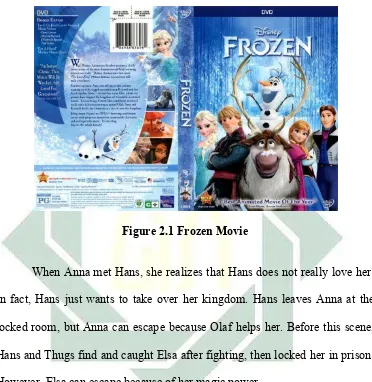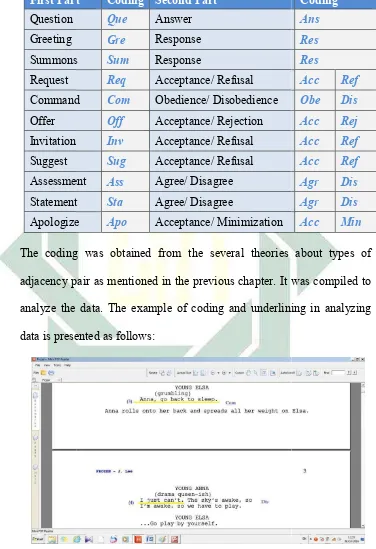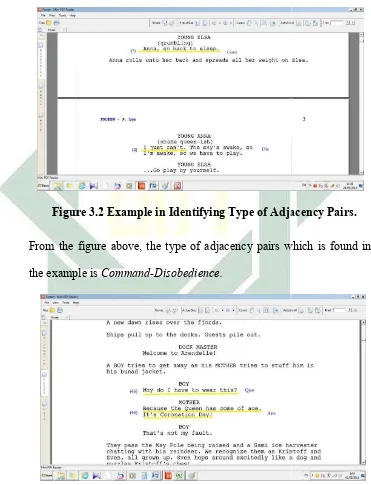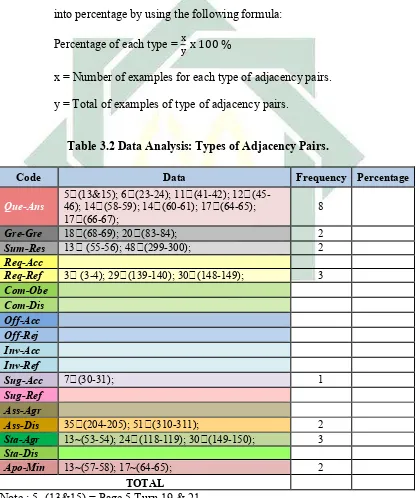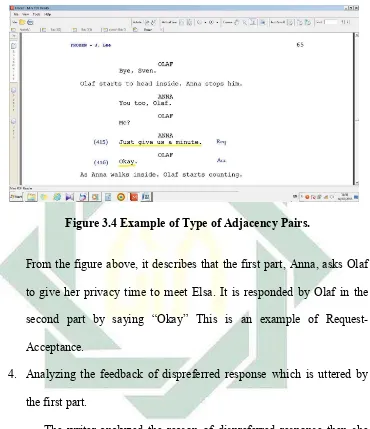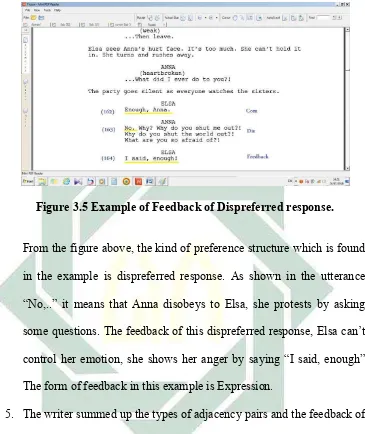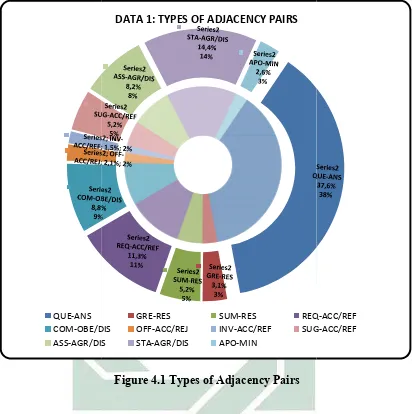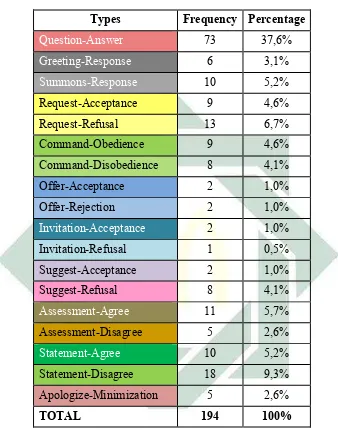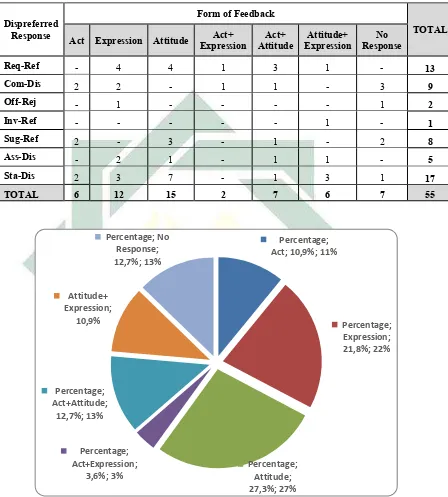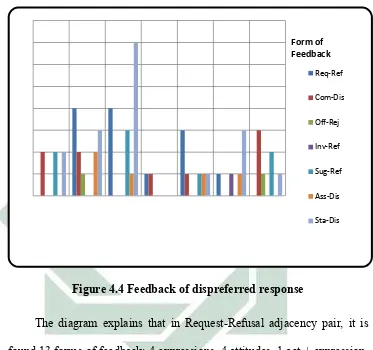THESIS
By Nur Hamidah Reg. Number A83212138
ENGLISH DEPARTMENT
FACULTY OF ARTS AND HUMANITIES
THE STATE ISLAMIC UNIVERSITY OF SUNAN AMPEL SURABAYA
2016
Submitted as Partial Fulfillment of the Requirements for the Sarjana Degree of English Department Faculty of Arts and Humanities the State Islamic University
ANALYSIS OF ADJACENCY PAIRS IN “FROZEN”: A MOVIE
BY CHRIS BUCK AND JENNIFER LEE
THESIS
By Nur Hamidah Reg. Number A83212138
ENGLISH DEPARTMENT
FACULTY OF ARTS AND HUMANITIES
THE STATE ISLAMIC UNIVERSITY OF SUNAN AMPEL SURABAYA
2016
Submitted as Partial Fulfillment of the Requirements for the Sarjana Degree of English Department Faculty of Arts and Humanities the State Islamic University
i
Buck and Jennifer Lee. English Department, Faculty of Arts and Humanities, State Islamic University of Sunan Ampel Surabaya.
The Advisor : Prof. Dr. Zuliati Rohmah, M. Pd
Key Terms :Adjacency Pair, Dispreferred Response, Feedback.
To conduct the conversation, both of the speakers should be interrelated in producing the utterances. This interrelated utterance is called adjacency pairs. An adjacency pair is a pair of interrelated utterances which consist of the first speaker and the second speaker. The aim of this study is to analyze adjacency pairs applied by all characters in “Frozen” movie, especially, about types of adjacency pairs and feedback of dispreferred response.
The basic theories used by the writer in this study were Levinson’s theory, Yule’s theory, and Rymes’s theory. The writer applied conversation analysis approach and descriptive research to analyze the data. The data were the utterances, sentences -without song lyrics- and expressions of all characters in ‘Frozen’ movie script. In this study, the writer was the main instrument to collect and analyze the data. The data were collected by downloading the ‘Frozen’ movie and the transcript, then reading it before coding or underlining the parts of dialogue which include adjacency pairs. Furthermore, the data were analyzed by identifying, classifying, and describing the utterances which include types of adjacency pairs, then analyzing the feedback of dispreferred response.
ii ABSTRAK
Hamidah, Nur. 2016. Analysis of Adjacency Pairs in “Frozen”: A Movie by Chris Buck and Jennifer Lee. Sastra Inggris, Fakultas Adab dan Humaniora. Universitas Islam Negeri Sunan Ampel Surabaya.
Pembimbing : Prof. Dr. Zuliati Rohmah, M. Pd
Kata Kunci : Pasangan ajasensi, Respon dispreferred, Umpan balik.
Untuk melakukanpercakapan, kedua pembicara harus saling berhubungan dalam memproduksi ujaran. Ucapan-ucapan yang saling terkait disebut pasangan ajasensi. Pasangan ajasensi adalah sepasang ucapan-ucapan yang saling terkait yang terdiri dari pembicara pertama dan pembicara kedua. Tujuan dari penelitian ini adalah untuk menganalisis pasangan adjacency digunakan oleh semua karakter dalam film "Frozen", terutama, tentang tipe-tipe pasangan ajasensi dan umpan balik dari respon dispreferred.
Dalam melakukan penelitian ini, teori-teori dasar yang digunakan penulis adalah teori Levinson, Yule dan Rymes. Penulis menggunakan analisis percakapan dan penelitian deskriptif untuk menganalisis data. Data adalah ucapan, kalimat – tanpa lirik lagu- dan ekspresi dari semua karakter dalam naskah film Frozen. Dalam penelitian ini, penulis adalah instrument utama dalam mengumpulkan dan menganalisis data. Data dikumpulkan dengan mengunduh film Frozen dan transkripnya, kemudian membaca transkrip tersebut sebelum memberi kode atau menggarisbawahi bagian dari dialog yang termasuk pasangan ajasensi. Selanjutnya, data dianalisis dengan mengidentifikasi, mengelompokkan, dan mendeskripsikan ucapan-ucapan yang meliputi tipe-tipe pasangan ajasensi, kemudian menganalisis umpan balik dari respon dispreferred.
Inside Title Page ... .ii
Declaration Page... .iii
Dedication Page ...iv
Motto ... v
Thesis Advisor’s Approval Page...vi
Thesis Examiner’s Approval Page ... vii
Acknowledgement ... viii
1.4Significance of the Study ... 8
1.5Scope and Limitations ... 8
1.6Definition of Key Terms ... 8
CHAPTER II REVIEW OF LITERATURE ... 10
2.1Theoretical Framework ... 10
CHAPTER III RESEARCH METHODS ... 20
3.1Research Design ... 20
3.2Data and Data Source ... 21
3.3Instrument ... 21
3.4Techniques of Data Collection ... 21
CHAPTER IV FINDINGS AND DISCUSSION ... 27
4.1Findings ... 27
4.1.1 Types of Adjacency Pairs ... 27
4.1.1.1 Question-Answer... 30
4.1.1.2 Greeting-Response ... 32
4.1.1.3 Summons-Response ... 33
4.1.1.4 Request-Acceptance / Refusal... 34
4.1.1.5 Command-Obedience / Disobedience ... 35
4.1.1.6 Offer-Acceptance / Rejection ... 37
4.1.1.7 Invitation-Acceptance / Refusal ... 38
4.1.1.8 Suggest-Acceptance / Refusal ... 39
4.1.1.9 Assessment-Aggree / Disagree ... 41
4.1.1.10 Statement-Agree / Disagree ... 42
4.1.1.11 Apologize-Minimization ... 44
4.1.2 Feedback of Dispreferred Response... 45
4.1.2.1Act ... 48
CHAPTER V CONCLUSION AND SUGGESTION ... 62
5.1Conclusion ... 62
5.2Suggestion ... 63 References
1
This chapter presents the explanation of background of study, research problems, research objectives, significance of the study, scope and limitations, and definition of key terms.
1.1 Background of Study
Language has the primary function of communication. Language is a tool used by people to communicate with one another. As known, there are two types of communication; verbal and nonverbal. One of the forms of verbal communication is a conversation. It is a form of social activity involves two or more participants in interacting or talking to each other. To conduct the conversation, both of the speakers should be interrelated in producing the utterances. This interrelated utterancesis called adjacency pairs. Therefore, in this study, the writer will analyze adjacency pairs, especially, about the types of adjacency pairs. In addition, the writer will also identify and describe the feedback of dispreferred response provided by all characters in Frozen movie.
Adjacency pair is one of the basic units of conversational organization.It is formed by two or more speakers consisting of the first speaker, the second speaker, and so on.
“Adjacency pairs as a two part interactional sequence in which the first part produces the expectation for the second part” (Rymes, 2008, p. 55).
2
“Adjacency pairs are tied pairs of utterances and ordered such that the issue of the first part in a turn sets up expectancy that the other will follow in the next turn” (p. 85).
Schegloff described that adjacency pairs are composed of a first pair part produced by one speaker directly and followed by second pair part’s utterance by a different speaker (2007, p. 13). The first parts are utterance types such as question, request, offer, etc. Whereas, the second parts are the response of utterance types such as answer, grant, accept, etc. It is concluded that in adjacency pairs, the component of utterances of the sequences must be adjacent and interrelated. For example,
Officer : Why do I have to wear this?
Manager : Because you are a new member in this room.
In the example above, it refers to Question-Answer type.Actually, there are some types of adjacency pairs presented by the theorists. Majid stated that there may be a large number of different types of adjacency pairs in a conversation and some of them might give more freedom for response as there are several options available as the second part. (2011, p. 142).
In the development of research about adjacency pairs, there are three parts of adjacency pairs structure, but it is produced by the first speaker and the second speaker. The rules are the utterances of the first speaker, then it followed by a response from the second speaker, and terminated by a further utterance from the first speaker (Mishler in Tsui, 1989, p. 548). The third turn is called as feedback.
Feedback is the response produced by the first speaker to the second speaker’s answer. The basic forms of feedback are classified by the writer as action, attitude and expression. These forms are inspired from psychological context. Then, it is combined with each other as another form, such as, act+attitude, act+expression, and attitude+expression. Besides, another form arises when this third turn does not occur, the writer called it ‘no response’. It is because the story moves on another topic of conversation, the setting or condition has changed, and there is another speaker interrupts the conversation.
4
and the good soundtrack. It is indicated by the amount of income earned. As
reported by Konnikova (2014), a contributing writer for newyorker.com,
“Since its release, “Frozen” has earned $1.2 billion worldwide, becoming the fifth-highest-grossing film of all time and by far the highest-grossing animation. That’s not to mention two Academy Awards, a Bafta, a Golden Globe, a soundtrack that’s garnered more than a million album sales and seven million Spotify streams, official YouTube video views in the hundreds of millions, and a DVD that became Amazon’s best-selling children’s film of all time based on advance orders alone”.
From this effect, the writer sees the situation as a good way to introduce the linguistic study to every person. The writer also wants to prove that the linguistic study can be used to analyze modern literary works in movie form. In addition, the writer wants to contribute by introducing how to analyze the adjacency pair to students of Sunan Ampel State Islamic University of Surabaya. Hence, as long as the writer’s knowledge, there is only one research in the university which focused on adjacency pair. Even, it uses a different research problem. So, this will be a good paper and useful to understand more about conversation analysis, especially about adjacency pairs.
movie. Every utterance had meaning and every conversation had a different pattern. The result of this study shows the patterns mostly used in the Red Riding Hood movie are automatic patterns. The pattern rarely used is the mixing of different sequences. In addition, the language functions are commonly used in the dialogue of Red Riding Hood Movie is request. While, other language functions which were rarely used include ‘hold’, ‘assessment’, ‘offer’, and ‘threat’.
Second, Fuad (2015) examines the conversation produced by those two main charactersin “Knight and day” movie -Roy Miller and June Heaven- and convinced that the conversation forms various types of adjacency pairs. He focused on four aspects of conversation those are turn – taking, adjacency pairs, preference organization, and pre-sequence and insertion sequence. The theories used are the Levinson theory. The research approach used in this study is conversational analysis (CA) approach to understand the organization of conversational interaction between participants. He found types of adjacency pair constructed by Roy Miller and June Heaven. The result of this study shows that the dominant type of adjacency pair comes from question-answer. While, the least data of the type of adjacency pair is invitation and suggestion type. Besides, He found some conversation that occurs are pre-sequence and insertion pre-sequence and also turns which almost balance between Roy and June.
6
interactions in indoor outdoor. She focuses on interaction between teacher and student in all occasion in English Day program at Mutiara Persada Elementary School. The participants in this research were 23 students of grade IV – Pegasus, which consisted of 10 girls and 13 boys and a non-native English teacher. The theories used are Rymes theory. The results of this study show that the greatest amount of teacher talk in indoor and outdoor category is primarily due to an emphasis on giving information and giving instructions. In contrast, student talks in indoor and outdoor categories are largely in the functions of responding physically and acknowledging.
for understanding, token yes, giving anaccount, mentioning obligation, saying an apology, and expressing doubt. (3) Social factors also influence the main character to do dispreferred act: the participants, the topic of conversation, function of the speaking, and the social context of interaction.
From the previous studies above, we can conclude that all focused on adjacency pairs, but they had different data sources and methods. Three of them have the same area with my research in collecting and analyzing the data, that is using data from movie. However, this study differs from those previous studies above. This study only focused on the types of adjacency pairs and the dispreferred response, especially, about feedback of it which was found in Frozen movie. Thus, this research will complete the previous studies.
1.2 Research Problems
The writer formulates the research problems as the following:
1. What are the types of adjacency pairs in the dialogue of Frozen’s, a
movie by Chris Buck and Jennifer Lee?
2. How is the feedback of dispreferred response in the dialogue of
Frozen’s, a movie byChris Buck and Jennifer Lee?
1.3 Research Objectives
In the relation to the problem statement above, the writer formulates the research objectives:
1. To describe the types of adjacency pairs in the dialogue of Frozen’s, a
8
2. To explain the feedback of dispreferred response in the dialogue of
Frozen’s, a movie by Chris Buck and Jennifer Lee.
1.4 Significance of the Study
Through this study, the writer wants to discover the application of adjacency pairs in the dialogue of the movie. The result of the research is expected to be used as one of the sources of information about adjacency pairs and preference structure. This might be used as a reference for those who are interested in studying conversational analysis in the movie.
1.5 Scope and Limitations
The scope of this research is text in the movie script and focused on adjacency pairs which found in Frozen Movie. This research limits the data of the types of adjacency pairs and the feedback of dispreferred responses which formed in Frozen movie through some theories about adjacency pairs. Then, the theories will be combined by the writer to collect and analyze based on the existing data.
1.6 Definition of Key Terms
1. Conversation is a form of verbal communication, it is defined as an
activity which doing by two or more people; they are talking about something with the certain purpose.
2. Adjacency pair is a pair of interrelated utterances which consist of the
3. First part is the speaker who has the first turn in conversation, usually make stimulus like as question, statement or etc.
4. Second part is the speaker who has the second turn in conversation,
usually it is the response of the first part utterance.
5. Preference structure is a pattern of dialogue produced by the second
speaker that refers to like or dislike, agree or disagree.
6. Preferred response is an expected response produced by the second
speaker, such as agree, acceptance.
7. Dispreferred response is an unexpected response produced by the
second speaker, such as disagree, refusal/ rejection.
8. Act is a response of someone by doing something.
9. Attitude is an invisible response, but it will be shown by someone
before or without doing something such as approving, ignore.
10.Expression is a response that arises to express the feeling or emotion of
someone.
11.Frozen is a 3D movie, which tells about the relationship between two
This chapter presents
which consist of discourse analysis;
preference structure, and F
2.1Theoretical Framework
2.2Relevant Theories
2.2.1 Discourse Analysis
Discourse analysis is a study of the relationship between
language and the context in which it is used. Discourse analysts study
language in use: written texts of all kinds, and spoken data, from
conversation to highly institutionalized forms of talk (McCa •Written
This chapter presents the theoretical framework, the relevant theories
discourse analysis; conversation analysis; adjacency pairs and
, and Frozen movie.
Theoretical Framework
Relevant Theories
Discourse Analysis
Discourse analysis is a study of the relationship between
language and the context in which it is used. Discourse analysts study
language in use: written texts of all kinds, and spoken data, from
conversation to highly institutionalized forms of talk (McCa Written
language and the context in which it is used. Discourse analysts study
language in use: written texts of all kinds, and spoken data, from
Discourse analysis focused on the constituent units and the structure of
the sentence. In addition, it also analyzes the larger units and structures
which are implicitly recognized by speakers and hearers at the level of
discourse, rather than at the level of the sentence.
Discourse analysis can be used in analyzing conversation. Mills
(1997, p. 136) explains conversations can be seen to be structured, and
can be analyzed in terms of the moves which participants make to
signal that, for example, they are initiating a new topic of conversation
or that they are reviving an older topic of conversation; these are using
discourse markers with phrases such as ‘well’, ‘OK’ and ‘anyway’.
These discourse markers only have a function at the level of discourse,
not at the level of the sentence. It is signalling the end of an exchange
or the initiation of a new topic.
Gee (1999) also adds discourse analysis is based on the details
of speech (and gaze and gesture and action) or writing that are
arguably deemed relevant in the situation and that are relevant to the
arguments the analyst is attempting to make. A discourse analysis is
not based on all the physical features present, not even all those that
might, in some conceivable context, be meaningful, or might be
meaningful in analyses with different purposes (p 88).
From the explanation above, it can be seen how important
discourse analysis in the production of language. Mills (1997, p. 142)
12
the structures and functioning of language within utterances, and it has
forced many mainstream and traditional linguists to shift their attention
from words in isolation to words within context.
2.2.2 Conversation Analysis
Conversational Analysis is an approach to the study of natural
conversation. Peräkylä (2015) in The Blackwell Encyclopedia of
Sociology Online, state that Conversation analysis (CA) is a method
for investigating the structure and process of social interaction between
humans. Sacks, Schegloff, and Jefferson in Coulthard (1985, p. 59)
also states “conversational analysis as a first step towards achieving a
‘naturalistic observational discipline’ to deal with details of social
interaction in a rigorous, empirical and formal way”.
Conversation analysis learns about the descriptions of recurrent
structures and practices of social interaction. Given (2008, p. 130)
stated that the researchers in Conversational Analysis work on audio-
or video recordings of interactions that are naturally occurring.
Litosseliti (2010, p. 121), also assumed that in the conversation
analysis, the use of audio or video recordings produced as transcripts,
will help the analysts in examining directly how talk organizes the
world within specific social settings. According to her, these following
are the key features of the Conversational Analysisapproach:
a) Orderliness in talk-in-interaction: Ordinary, everyday speech
orderliness is not governed by innate cognitive structures of
language (although grammatical features clearly inform the
structure of utterances), but reflects a socially organized
structure of interpersonal action. This orderliness, known as
‘the speech-exchange system’ is apparent in the pattern of
sequential turn-taking.
b) A data-centred approach: Conversational Analysis has a
primary interest in transcript data and what these data reveal.
c) A neutral and objective stance: Analysts are discouraged from
bringing any theoretical or philosophical presuppositions to the
data, in order to allow these to ‘speak for themselves’. A priori
speculation in terms of speaker ‘orientations’, motivations and
identities, social settings and cultural norms, are regarded as
distracting and irrelevant. Factors ‘external’ to the data, such as
gender inequalities or cultural misunderstandings may be
‘made relevant’ by the participants in the transcript data. It is
on this basis alone that external factors become available to the
analyst for comment and interpretation.
2.2.3 Adjacency Pairs
Yule (1996, p. 77) states “adjacency pairs are the automatic
patterns in the structure of conversation”. It constantly contains a first
part and a second part, formed by dissimilar speakers. In same line
14
part interactional sequence in which the first part produces the
expectation for the second part.
Some characteristics in adjacency pairs are presented by
Schegloff and Sacks (1973), they are (i) adjacent; (ii) produced by
different speakers; (iii) ordered as first part and second part; (iv) typed,
so that a particular first part requires a particular second or range of the
second part (see at Levinson, 1983, p. 303).
Sacks and Schegloff (1973) described that the basic rule of
adjacency pairs operations is to give the recognizable production of a
first pair part, on its first possible completion its speaker should stop
and a next speaker should start and produce a second pair part from the
pair type of which the first is recognizably a member (p. 74).
There are some types of adjacency pairs. According to Yule
(1996, p. 77) they includes greeting-greeting, question-answer, a
thanking-response, and request-accept. Whereas, Rymes classified that
some typical of adjacency pairs are greeting/ greeting; question/
answer; invitation/ acceptance; assessment/ disagreement; apology/
acceptance; and summons/ acknowledgement (2008, p. 38). In
addition, Majid stated that there may be a large number of different
types of adjacency pairs in a conversation and some of them might
give more freedom for response as there are several options available
2.2.4 Preference Structure
Levinson (1983, p. 332) stated that there is an element in
adjacency pairs called as preference organization. It is divided into
preferred and dispreferred. The first is preferred action, which is the
action of the second part which gives an expected response to the first
parts. While, the second one is dispreferred action, which is the action
of the second part which gives an unexpected response to the first part.
Yule (1996, p. 79) also has the same idea, preference structure
divides second parts into preferred and dispreferred social act. The
preferred is structurally expected next act and the dispreferred is the
structurally unexpected next act.
The general pattern of preference structure according to
Levinson in Yule (p. 79):
First Part Second Part
Preferred Dispreferred
Assessment Agree Disagree
Invitation Accept Refuse
Offer Accept Decline
Proposal Agree Disagree
Request Accept Refuse
Usually, the giving response by the second speaker will make
the first speaker takes his turn to produce the response, is called
16
followed by a response from the second speaker, and terminated by a
further utterance from the first speaker (Mishler in Tsui, 1989, p. 548).
The similar opinion is delivered by Coulthard (I992) in his
research, he points out that there are three-part exchanges in classroom
discourse: an initiation from the teacher, then followed by a response
from the pupil, and then followed by a feedback from the teacher
which evaluates the response provided by the pupil (p. 3).
Rankema (2004) also assumed that the sequence of the
adjacency pair not only limited on the two adjacent sequences of
utterances. There are also other sequences that often occur and need to
be acknowledged as important as well, such as three-part sequences.
According to her, the three-part structure is the response from the first
speaker as a result of the act of the second speaker (p. 166). For
example:
Student 1 : Can you help me? Student 2 : I’m sorry, I’m still busy. Student 1 : Please.
The example above explains about dispreferred response produced by
the second speaker, then it followed by feedback of the first speaker.
To describe the feedback, the terms used are inspired from
psychological context. The basic terms are Act, Attitude, and
Expression. Act is known as a response arises as the result of external
“Tindakan adalah mekanisme dari suatu pengamatan yang muncul dari persepsi sehingga ada respon untuk mewujudkan suatu tindakan”(p.46).
Meanwhile, Attitude is identified as “a disposition to react
favorably or unfavorably to a class of objects” (Sarnoff in Sadighi &
Zarafshan, 2006, p. 72). Attitude also identified as one’s readiness to
act, it means that attitude can affect someone to act. The next term is
expression. According to Darwin in Russel and Dolz (1997, p. 7), the
notion of expression was extremely general. It is not only about a
small set of facial "signal", but also describes any state of mind or
feeling. It is intended by the writer as a response used by the speaker
by showing the feeling or emotion.
2.3Frozen Movie
Frozen is an animated film served with 3D quality and produced by
Walt Disney Studio Motion Pictures. Frozen is starring by Elsa as the queen,
Anna as a little sister of the queen, Kristoff as the mountain man, Olaf as a
snowman and Hans as a prince of the southern isles.
The movie is a commercial success. This is evidenced by the amount
over $1.2 billion in worldwide box office revenue, $400 million of which were
earned in the United States and Canada and $247 million of which were
earned in Japan. It ranks as the highest-grossing animated film of all time, the
ninth highest-grossing film of all time, the highest-grossing film of 2013, and
18
Academy Awards for Best Animated Feature and Best Original Song ‘Let It
Go’ (http://disney.wikia.com).
Besides, this movie also has an interesting story. The story of this
movie tells about the relationship of two sisters, Elsa and Anna. The story
begins on their close relationship when they were little, they love to make a
snowman with ice magic Elsa. One day, the ice magic injured Anna's head
while they are playing, so Anna fainted. Elsa is very shocked, She and her
parents (the king and queen) are looking for the trolls to cure Anna. Grand
Pabbie, as an elder troll, heals Anna by removing all memories of the magic,
so Anna can not remember that Elsa has a magic. Because of the incident, Elsa
always avoids and be indifferent to Anna.
The complication of this story occurs in the coronation day. Anna
asked for the blessing to be married to Hans. When Elsa disapprove it, Anna
protests and urged Elsa, finally, Elsa angry and accidentally ice magic was
thrown out of her hand. It makes all people in shocked. Elsa feels fear and
runs out from the castle. Anna feels guilty and tries to pursue Elsa. She meets
Kristoff and Olaf in the middle of the way. At the last, they are looking for
Elsa together.
When they meet Elsa, Anna asks Elsa to come back and stay in
Arendelle, but, Elsa refuses it. When they are debating each other,
accidentally, the magic of Elsa injures Anna’s heart. Anna becomes weak and
her hair slowly white. Because of this effect, Grand Pabbie says that Anna can
love is about kissing by someone who loves Anna. They assume that Hans is
an intended person.
Figure 2.1 Frozen Movie
When Anna met Hans, she realizes that Hans does not really love her.
In fact, Hans just wants to take over her kingdom. Hans leaves Anna at the
locked room, but Anna can escape because Olaf helps her. Before this scene,
Hans and Thugs find and caught Elsa after fighting, then locked her in prison.
However, Elsa can escape because of her magic power.
Finally, when they escape in the storm of snow, Anna sees her sister in
a danger. It is because Hans will kill her. Anna runs and saves her sister in the
weak condition. Because of the magic effect, Anna’s body become froze when
she arrest Hans's sword. Elsa realizes it, she cries and hugs Anna. This act
makes the frozen thawed. So, the act of true love which referred in the story is
not about kissing, but about two sisters who love each other. From the
20
CHAPTER III
RESEARCH METHODS
This chapter explains about research design, data and data sources,
instruments, techniques of data collection, and techniques of data analysis.
3.1 Research Design
In this study, the writer applied the descriptive method because it
focuses on the interaction between all characters in the movie. Aggarwal in
Salaria (2012) states “Descriptive research is devoted to the gathering of
information about prevailing conditions or situations for the purpose of
description and interpretation” The Office of BSSRO (2016) also described
that descriptive study is one in which information is collected without
changing the environment or nothing is manipulated. So, it was the best
methods for collecting the information and describing the existing data.
In addition, the writer used Conversational Analysis (CA) as a research
approach to identify and describe the utterances that include adjacency pairs
and preference structure in Frozen movie. Conversational Analysis is an
approach within the social sciences that aims to describe, analyze and
understand talk as a basic and a constitutive feature of human social life.
(Sidnell, 2010, p. 1). Peräkylä (2015) in The Blackwell Encyclopedia of
Sociology Online, alsostated that Conversation analysis (CA) is a method for
3.2 Data and Data Source
The data of this study were the utterances, sentences -without song
lyrics and expression of the conversation whole characters in Frozen movie
script. Whereas, the data sources of this study were Frozen movie and the
transcript. The movie was taken from YouTube, while the transcript was taken
from www.goodinaroom.com/wp-content/uploads/frozen in a pdf file.
3.3 Instrument
For the instrument of study, the writer used her own brain to collect
and to analyze the data. In addition, the writer counted the frequency of types
of adjacency pairs and described the feedback of dispreferred response by
herself.
3.4 Techniques of Data Collection
The procedures of collecting the data in this study are:
1. The writer downloaded the Frozen movie, it was taken from YouTube.
2. The writer downloaded the transcript of Frozen movie, it was taken
from www.goodinaroom.com/wp-content/uploads/frozen.
3. The writer read the transcript when she watched the movie to match
and check the transcript.
4. The writer coded or underlined the utterances in the transcript that
First Part
Table 3.1 Coding: Types of Adjacency Pairs
First Part Coding Second Part
Que Answer
Gre Response
Summons Sum Response
Req Acceptance/ Refusal
Command Com Obedience/ Disobedience
Off Acceptance/ Rejection Invitation Inv Acceptance/ Refusal
Sug Acceptance/ Refusal Assessment Ass Agree/ Disagree
Statement Sta Agree/ Disagree
Apologize Apo Acceptance/ Minimization
ding was obtained from the several theories about type
adjacency pair as mentioned in the previous chapter. It was
analyze the data. The example of coding and underlining in analyzing
presented as follows:
Figure 3.1 Example in Coding and Underlining.
3.5 Techniques of Data Analysis
In analyzing the data, the writer use
1. Identifying
based on theories.
Figure
From the figure
the example
Figure
Data Analysis
In analyzing the data, the writer used several steps.
ing the types of adjacency pairs which is found in
on theories.
Figure 3.2 Example in Identifying Type of Adjacency Pair
the figure above, the type of adjacency pairs which
the example is Command-Disobedience.
Figure 3.3 Example in Identifying Type of Adjacency Pair
found in the transcript
f Adjacency Pairs.
which is found in
24
From the figure above, the type of adjacency pairs which is found in
the example is Question-Answer.
2. Classifying the types of adjacency pairs which is found in the
transcript.
The writer applied each total number of types of adjacency pairs
into percentage by using the following formula:
Percentage of each type = x 100 %
x = Number of examples for each type of adjacency pairs.
y = Total of examples of type of adjacency pairs.
Table 3.2 Data Analysis: Types of Adjacency Pairs.
Code Data Frequency Percentage
Que-Ans 5(13&15); 6(23-24); 11(41-42); 12(45-46); 14(58-59); 14(60-61); 17(64-65);
17(66-67); 8
Ass-Dis 35(204-205); 51(310-311); 2 Sta-Agr 13~(53-54); 24(118-119); 30(149-150); 3 Sta-Dis
Apo-Min 13~(57-58); 17~(64-65); 2
TOTAL
3. Describing the utterances which include the types of adjacency pairs.
Figure 3.4 Example of Type of Adjacency Pairs.
From the figure above, it describes that the first part, Anna, asks Olaf
to give her privacy time to meet Elsa. It is responded by Olaf in the
second part by saying “Okay” This is an example of
Request-Acceptance.
4. Analyzing the feedback of dispreferred response which is uttered by
the first part.
The writer analyzed the reason of dispreferred response then she
26
Figure 3.5 Example of Feedback of Dispreferred response.
From the figure above, the kind of preference structure which is found
in the example is dispreferred response. As shown in the utterance
“No,..” it means that Anna disobeys to Elsa, she protests by asking
some questions. The feedback of this dispreferred response, Elsa can’t
control her emotion, she shows her anger by saying “I said, enough”
The form of feedback in this example is Expression.
5. The writer summed up the types of adjacency pairs and the feedback of
dispreferred response which is found in Frozen movie by Chris Buck
27
CHAPTER IV
FINDINGS AND DISCUSSION
This chapter presents the findings obtained from the research and
discussion of the result. It deals with the analysis of adjacency pairs in Frozen
movie.
4.1 Findings
The explanation of adjacency pairs in the Frozen dialogues is delivered
in two parts. First, it is about the types of adjacency pairs. Second, it is about
the feedback of dispreferred response. In this study, there are 722 turns in the
conversation of the whole characters. The data include 194 types of adjacency
pairs. Those data are classified into 11 types based on the dialogues of the
characters which paired. For details of the data, it can be seen at appendix 1.
In addition, the writer also found 7 of 11 types which have dispreferred
responses and the data for feedback of dispreferred response has calculated by
amount 55 data. For details of the data about feedback, it can be seen at
appendix 2.
4.1.1 Types of Adjacency Pairs
The results of data analysis about types of adjacency pair appears in
Based on figure 4.1, it ca
Figure 4.1 Types of Adjacency Pairs
4.1, it can be seen that the highest type of adjacency pair
Answer, which is 73 data representing 37,6 % of all data
lowest number is Invitation-Acceptance/Refusal, which is 3 data
For certain types of adjacency pairs, the first parts are not always
responded positively (as preferred by the first speaker), some of them are
responded negatively (dispreferred responses). The types are elaborated more
specifically as shown in the following table.
Table 4.1 Types of Adjacency Pairs (Part 2)
Types Frequency Percentage
Question-Answer 73 37,6%
Greeting-Response 6 3,1%
Summons-Response 10 5,2%
Request-Acceptance 9 4,6%
Request-Refusal 13 6,7%
Command-Obedience 9 4,6%
Command-Disobedience 8 4,1%
Offer-Acceptance 2 1,0%
Offer-Rejection 2 1,0%
Invitation-Acceptance 2 1,0%
Invitation-Refusal 1 0,5%
Suggest-Acceptance 2 1,0%
Suggest-Refusal 8 4,1%
Assessment-Agree 11 5,7%
Assessment-Disagree 5 2,6%
Statement-Agree 10 5,2%
Statement-Disagree 18 9,3%
Apologize-Minimization 5 2,6%
TOTAL 194 100%
For example of each type of adjacency pairs in Frozen movie, it can be seen at
appendix 3. While, the further discussion for each type of adjacency pairs will
30
4.1.1.1 Question-Answer
Question-Answer type is the biggest amount of adjacency pairs
which is found in the data. In this type, the second part will give the
answer for the question by the first part. The writer has found 73 data
for Question-Answer type. To represent this type, I provide 5
examples as follows:
Example 1 (Page 11 Turn (41-42))
TEEN ELSA : Do you have to go?
KING : You’ll be fine, Elsa
In example 1, the first part, Teen Elsa, has uttered a question for
her father clearly “Do you have to go?” This utterance is responded
by the second part “You’ll be fine. Elsa” is indirect answer that means
‘yes’ the King has to go.
Example 2 (Page 24 Turn (117-118))
HANS : (about her white streak) What’s this?
ANNA : I was born with it, although I dreamt I was kissed
by a troll.
In example 2, the first part, Hans, asks question about part of
Anna’s hair because the color is white “What’s this?” It is answered by
Anna by saying that she was born with white streak on her hair, even
though she dreamt she was kissed by troll.
Example 3 (Page 40 Turn (224-225))
OAKEN : A real howler in July, yah? Where ever could it be
coming from?
In example 3, the first part, Oaken, asks a question to Kristoff
about the source of winter in July “Where ever could it be coming
from?” It is answered directly by Kristoff in the second part that the
source of winter is coming from the North Mountain.
Example 4 (Page 45 Turn (256-257))
KRISTOFF : So tell me, what made the Queen go all ice-crazy? ANNA : ...Oh well, it was all my fault. I got engaged but
then she freaked out because I’d only just met him, you know, that day. And she said she wouldn’t bless
the marriage—
In example 4, the first part, Kristoff, asks question or explanation
about the reason why Queen made the winter. He asks “…What made
the Queen go all ice-crazy?” Anna answered it by explaining the
reason of it in the second part “…it was all my fault. I got engaged but
then she freaked out because I’d only just met him, you know, that
day. And she said she wouldn’t bless”.
Example 5 (Page 53 Turn (326-327))
OLAF : Wait, what am I looking at right now? Why are
you hanging off the earth like a bat?
ANNA : ...Okay. Wait one second.
In example 5, the first part, Olaf, is confused about his self. He
asks “…Why are you hanging off the earth like a bat?” It is answered
by Anna in the second part “Okay. Wait one second.” This response
seems unrelated with the question. But, the act of Anna after saying
“Wait one second” is the answer of the question: Anna changes the
32
4.1.1.2 Greeting-Response
Greeting-Response is a type of adjacency pairs which is uttered
when the person wants to know each other, such as introduce the name
or greeting (‘Hi’, ' Hello’). It occurs because both of the speakers never
meet before. Sometimes, the response of greeting is greeting also, or
maybe other responses. The writer has found 6 data and only 3 data
will represent this type.
Example 6 (Page 18 Turn (68-69))
HANS : Prince Hans of the Southern Isles.
ANNA : Princess Anna of Arendelle.
In example 6, the first part, Hans, gives a greeting to Anna by
introducing himself as Prince Hans of the Southern Isles. Then, in the
second part, Anna replies it by introducing herself as Princess Anna of
Arendelle.
Example 7 (Page 20 Turn (83-84))
ELSA : ...Hi.
ANNA : Hi me...? Oh. Um. Hi.
In example 7, the first part, Elsa, gives a greeting to Anna by
saying “Hi” It is responded by greeting also “Hi me...? Oh. Um. Hi.”
The response indicates that Anna hesitates, but at the last she answers
the greeting.
Example 8 (Page 53 Turn (316-317))
OLAF : Hi!
In example 8, the first speaker, Olaf, gives a greeting to Kristoff
by saying “Hi” It is responded by Kristoff as the second speaker
“You’re creepy” Although the response of Kristoff is not greeting also,
but it occurs in the first meeting and this utterance is produced because
Kristoff is shocked when he hold Olaf’s head.
4.1.1.3 Summons-Response
Summons-Response is a type of adjacency pairs which is
produced to call someone. It often occurred at the beginning of
meeting. Usually, the way of summons is calling the name of person. It
means that the interlocutor has known each other. The response of
summons can be call the name also or give other response. The writer
has found 10 data for this type and only 3 data will represent it.
Example 9 (Page 13 Turn (55-56))
KAI : Princess Anna...?
ANNA : Huh? Yeah?
In example 9, the first part, KAI, summons Anna from out of the
door by calling “Princess Anna..?” It is replied by Anna in the second
part by saying “Huh? Yeah?”.
Example 10 (Page 65 Turn (418-419))
ANNA : Elsa? It's me...Anna?!
ELSA : Anna.
In example 10, the first part, Anna, summons her sister, Elsa, in
the Elsa’s castle “Elsa? It's me...Anna?!” Then, it is responded by Elsa
34
Example 11 (Page 75 Turn (485-486))
ANNA : Olaf!
OLAF : Hang in there, guys!
In example 11, the first speaker, Anna, summons Olaf because
she sees Olaf has fallen into the ravine. It is responded by Olaf in the
second part by saying “Hang in there, guys!”.
4.1.1.4 Request-Acceptance / Refusal
Request-Acceptance/Refusal type is a type of adjacency pair
which is uttered when the person needs or asks someone to do
something. There are 2 responses of this type: acceptance and refusal.
Acceptance indicates the preferred response, while refusal indicates
the dispreferred response. The writer has found 22 data for
Request-Acceptance/Refusal type, it consist of 9 data is preferred response and
13 data is dispreferred response. To represent this type, I deliver 3 data
as follows:
Example 12 (Page 35 Turn 205-207))
HANS : I’m coming with you.
ANNA : No, I need you here to take care of Arendelle.
HANS : On my honor
In example 12, the first part, Anna, asks Hans to take care of
Arendelle when she left to find Elsa. It is responded by Hans in the
second part by saying “On my Honor.” This is an example of request
which is responded by acceptance or it called by the preferred
Example 13 (Page 44 Turn (249-250))
ANNA : Take me up the North Mountain.... Please.
KRISTOFF : We leave at dawn.... And you forgot the carrots for Sven.
In example 13, the first part, Anna, requests Kristoff to take her
up to the North Mountain “Take me up the North Mountain.... Please.”
It is responded by Kristoff in the second part by saying “We leave at
dawn…” This response seems accept the request, but it is a refusal. It
occurs because in fact, Anna wants to go as soon as possible. This is an
example of request which is responded by refusal, or it called by the
dispreferred response.
Example 14 (Page 91 Turn (582-583))
ELSA : You have to tell them to let me go.
HANS : I will do what I can.
In example 14, the first speaker, Elsa, requests Hans to tell the
guard to let her go. It is responded by Hans with indirect meaning. He
says "I will do what I can." which indicates that Hans refused the
request. This is another example of dispreferred response.
4.1.1.5 Command-Obedience / Disobedience
This is a type of adjacency pairs which is produced when the
person wants to give instruction to other. There are 2 responses of this
type: acceptance and refusal. Acceptance indicates the preferred
response, while refusal indicates the dispreferred response. The writer
36
response and 8 data is dispreferred response. There are 3 data to
represent this type as follows:
Example 15 (Page 7 Turn (26-27))
KING : Do what you must.
GRAND PABBIE : I recommend we remove all magic, even memories of magic to be safe.... But don’t worry, I’ll leave the fun.
In example 15, the first part, King, gives a command to Grand
Pabbie to do what the best for Anna’s condition by saying “Do what
you must.” It is responded by Grand Pabbie in the second part by
removing all magic on Anna’s mind. The response shows that Grand
Pabbie is obey to the King. This is one of preferred response example.
Example 16 (Page 92 Turn (586-587))
KRISTOFF : Stay out of sight, Olaf!
OLAF : I will!
In example 16, the first speaker, Kristoff, gives a command to
Olaf to keep hide from people by saying “Stay out of sight, Olaf!” It is
responded by Olaf as the second speaker with saying “I will!” The
response points out that Olaf obey to Kristoff. This is another example
of preferred response.
Example 17 (Page 47 Turn (284-285))
KRISTOFF : Stop talking.
ANNA : No, no, no. I’d like to meet these—
In example 17, the first part, Kristoff, gives a command to Anna
“Stop talking.” Anna responds it in the second part by saying “No…”
The response shows that Anna did not obey to Kristoff. This is one of
dispreferred response examples.
4.1.1.6 Offer-Acceptance / Rejection
Offer-Acceptance / Rejection is a type of adjacency pair which is
produced when the person wants to do something with intend to offer
aid, service or etc. There are 2 responses of this type; acceptance and
rejection. Acceptance indicates the preferred response, while rejection
indicates the dispreferred response. The writer has found 4 data for
Offer-Acceptance/Rejection type, it consists of 2 data is preferred
response and 2 data is dispreferred response. There are only 2 data for
representing this type.
Example 18 (Page 25 Turn (126-127))
ANNA : Okay, can I just say something crazy?
HANS : I love crazy.
In example 18, the first part, Anna, offers to say something crazy
to Hans “…can I just say something crazy?” It is responded by Hans
with saying “I love Crazy.” The response points out that Hans accepted
what Anna’s offer. This is one of preferred response example.
Example 19 (Page 21 Turn (92-93))
DUKE : Your Majesty, as your closest partner in trade, it seems only fitting that I offer you your first dance as queen.
38
In example 19, the first part, Duke, offers Elsa to dance with him
“…I offer you your first dance as queen.” It is replied by Elsa in the
second part by saying “Thank you...only I don’t dance.” The response
indicates that Elsa refused what Duke’s offer. This is an example of
dispreferred response.
4.1.1.7 Invitation-Acceptance/Refusal
Invitation-Acceptance, it is the type which is uttered when the
person wants to invite someone to follow or to come, usually using
‘come on’, ‘come with me’, or etc. There are 2 responses of this type;
acceptance and refusal. Acceptance indicates the preferred response,
while refusal indicates the dispreferred response. The writer has found
3 data for this type and all of them are representing it.
Example 20 (Page 80 Turn (524-525)
KRISTOFF : Wait. Come here.
ANNA : Oooh.... That’s nice.
In example 20, the first part, Kristoff, invites Anna to follow him
to through the way “Wait. Come here.” It is responded by Anna in the
second part by saying “Oohh... That’s nice.” It indicates that Anna
accepted the invitation. This is the example of preferred response.
Example 21 (Page 58 Turn (358-359))
OLAF : So, come on! Elsa’s this way. Let’s go bring back
summer!
In example 21, the first part, Olaf, invites Anna to follow him to
through the way which Elsa ever passed “…come on! Elsa’s this way.
Let’s go bring back summer.” It is responded by Anna with saying
“I’m coming.” The response shows that Anna accepted Olaf’s
invitation. This is another example of preferred response.
Example 22 (Page 52 Turn (313-314))
ANNA : ...Yeah. Now come on. This way to the North
Mountain.
KRISTOFF : More like this way.
In example 22, the first part, Anna, invites Kristoff to follow him
to through the way by saying “…Now come on. This way to the North
Mountain.” In the second part, Kristoff refuses it by saying “More like
this way.” This is one of dispreferred response example.
4.1.1.8 Suggest-Acceptance / Refusal
Suggest-Acceptance / Refusal is a type of adjacency pairs which
produced when the person want to give a suggestion to others. There
are 2 responses of this type; acceptance and refusal. Acceptance refers
to the preferred response, while refusal refers to the dispreferred
response. The writer has found 10 data for this type, it consists of 2
data is preferred response and 8 data is dispreferred response. To
represent this type, I provide 3 data as sampling to represent this type.
Example 23 (Page 87 Turn (568-569)
KRISTOFF : Anna, we’ve got to get you back to Hans.
40
In example 23, the first speaker, Kristoff, utters “Anna, we’ve
got to get you back to Hans.” which means that Kristoff gave a
suggestion to get Anna back because Anna in weak condition. Then, it
is responded by Anna as the second speaker by saying “…Hans.” From
the utterance and expression, it indicates that Anna accepted the
suggestion. This is one of preferred response examples.
Example 24 (Page 69 Turn (446-447))
ANNA : It’s okay, you can just unfreeze it
ELSA : No, I can’t. I don’t know how
In example 24, the first part, Anna, suggests her sister, Elsa, to
make a better condition by saying “…you can just unfreeze it.” It is
responded by Elsa by saying "No, I can’t…" The response points out
that Elsa refused the suggestion. This is an example of dispreferred
response.
Example 25 (Page 102 Turn (662-663))
OLAF : No, no, no, no, no. You need to stay by the fire and
keep warm.
ANNA : I need to get to Kristoff.
In example 25, the first part, Olaf, suggests Anna to keep close to
the fire and keep warm by saying “…You need to stay by the fire and
keep warm.” It is responded by Anna by saying "I need to get to
Kristoff." The response indicates that Anna refused the suggestion
because she has an opinion to meet Kristoff. This is another example
4.1.1.9 Assessment-Agree / Disagree
Assessment-Agree / Disagree type is a type of adjacency pairs
which is produced when a person assesses something/ someone. There
are 2 responses of this type; agree and disagree. Agree refers to the
preferred response, while disagree refers to the dispreferred response.
The writer has found 16 data for this type, it consists of 11 data is
preferred response and 5 data is dispreferred response. There are 3 data
to represent this type.
Example 26 (Page 25 Turn (122-123))
HANS : Twelve older brothers. Three of them pretended I
was invisible... literally...for two years.
ANNA : That’s horrible.
HANS : It’s what brothers do.
In example 26, the first part, Anna, assesses Hans story by saying
“That’s horrible.” It is responded by Hans by saying “It’s what
brothers do.” The response indicates that Hans agreed with the
assessment about his brother. This is one of preferred response
examples.
Example 27 (Page 65 Turn (420-421))
ANNA : Elsa, you look different.... It’s a good different.... And this place is amazing.
ELSA : Thank you, I never knew what I was capable of.
In example 27, the first part, Anna, assesses her sister by saying
that Elsa looks different and the place is amazing. It is responded by
42
that Elsa agreed with Anna’s assessment. This is another example of
preferred response.
Example 28 (Page 35 Turn (204-205))
HANS : Anna, no. It’s too dangerous.
ANNA : Elsa’s not dangerous. I’ll bring her back, and I’ll make this right.
In example 28, the first part, Hans assesses that Anna’s decision
is dangerous. It responded by Anna by saying “Elsa’s not
dangerous…” The response points out that Anna disagreed with
Hans’s assessment. This is an example of dispreferred response.
4.1.1.10 Statement-Agree / Disagree
This is a type of adjacency pairs which is produced when the
person wants to state or assert something. It is like the assertive
sentence. There are 2 responses of this type; agree and disagree. Agree
refers to the preferred response, while disagree refers to the
dispreferred response. The data of this type was found by amount 28
data, it consists of 10 data is preferred response and 18 data is
dispreferred response. There are 3 data to represent this type.
Example 28 (Page 102 Turn (663-664))
ANNA : I need to get to Kristoff.
OLAF : Why...? (realizing) Oh, oh, oh, I know why.
In example 28, the first speaker, Anna, states that she needs to
meet Kristoff. It is responded by Olaf as the second speaker by asking
agreed with saying "Oh, I know why." This is one of preferred
response examples.
Example 29 (Page 107 Turn (688-689))
OLAF : An act of true love will thaw a frozen heart.
ELSA : Love...will thaw...(realizing) Love.... Of course.
In example 29, the first part, Olaf, states that an act of true love
will thaw a frozen heart. It is uttered when Olaf sees Anna’s body has
thawed. It responded by Elsa as the second part “…Love... Of course.”
The response means that Elsa realized about an act of true love, she
agreed with the statement. This is another example of preferred
response.
Example 30 (Page 56 Turn (353-354))
OLAF : Summer? (sinking into wistfulness) Oh, I don’t
know why but I’ve always loved the idea of summer, and sun, and all things hot.
KRISTOFF : Really? I’m guessing you don’t have much experience with heat.
In example 30, the first part, Olaf, states his feeling that he
always loved the idea of summer and sun, and all things hot. It is
responded by Kristoff by saying "Really? I’m guessing you don’t have
much experience with heat." The response indicates that Kristoff
disagreed with the statement. This is one of dispreferred response
examples.
Example 31 (Page 67 Turn (439-440))
44
ANNA : You don’t have to protect me. I’m not afraid. Please don’t shut me out again.
In example 31, the first part, Elsa, states that she just trying to
protect Anna, it uttered as her reason why she can’t live with Anna.
Then, it is responded by Anna in the second part "You don’t have to
protect me…" The response shows that Anna disagreed with Elsa’s
statement. This is another example of dispreferred response.
4.1.1.11 Apologize-Minimization
This is a type of adjacency pair which is uttered when the person
wants to apologize to others. The response of apologies is
minimization. The writer has found 5 data for this type. To represent
this type, I provide 2 data as follows:
Example 32 (Page 13 Turn (57-58))
KAI : Sorry to wake you, ma’am but--
ANNA : No, you didn’t. I’ve been up for hours.
In example 32, the first speaker, Kai, utters “Sorry to wake you,
ma’am…” means that he apologized to Anna because he has to wake
Anna. This utterance is responded by Anna as the second speaker by
saying "No, you didn’t, I’ve been up for hours." The response points
out that Anna forgive and minimized the problem.
Example 33 (Page 66 Turn (422-423))
ANNA : ...I’m so sorry about what happened. If I’d
known—
ELSA : No, it’s okay. You don’t have to apologize.... But
In example 33, the first part, Anna, apologize to Elsa about her
mistakes which make a big problem by saying “I’m so sorry about
what happened…” It responded by Elsa in the second part “No. It’s
okay, You don’t have to apologize.” The response shows that Elsa
forgive and minimized the problem.
To sum up, there are 11 types of adjacency pairs which found in
the data. They are Question-Answer, Greeting - Response, Summons -
Response, Request - Acceptance/Refusal, Command -
Obedience/Disobedience, Offer - Acceptance/Rejection, Invitation -
Acceptance/refusal, Suggest - Acceptance/refusal, Assessment -
Agree/Disagree, Statement Agree/Disagree, and Apologize
-Minimization.
4.1.2 Feedback of Dispreferred Response
Feedback of dispreferred response is the reaction of the first
speaker about the unexpected response which is uttered by the second
speaker. Some reactions can be accompanied by the utterance. The writer
has classified feedback of dispreferred response based on the data analysis
into 7 forms; they are an act, expression, attitude, act + expression, act +
attitude, attitude + expression and no response. The terms of these forms
are created by the writer herself based on the existing data.
The writer found 7 types of adjacency pairs which have
dispreferred responses. It has calculated by amount 55 data. To describe it
46
Table 4.3 Feedback of dispreferred response
Dispreferred Response
Form of Feedback
TOTAL Act Expression Attitude Expression Act+ Attitude Act+ Expression Attitude+ Response No
Req-Ref - 4 4 1 3 1 - 13
Figure 4.3 Feedback of dispreferred response in percentage
Based on the diagram above, it appears that the highest form of feedback
percentage 27,3 %. While the lowest form of feedback of dispreferred
response is Act + Expression, with the frequency 2 and the percentage
3,6%. The following diagram will explain more detail:
Figure 4.4 Feedback of dispreferred response
The diagram explains that in Request-Refusal adjacency pair, it is
found 13 forms of feedback: 4 expressions, 4 attitudes, 1 act + expression,
3 acts + attitudes, and 1 attitude + expression. Then, in
Command-Disobedience, is responded by 9 forms of feedback: 2 acts, 2 expressions,
1 act + expression, 1 act + attitude, and 3 no responses. Next, the writer
has found 2 forms of feedback in Offer-Rejection, they are 1 expression
and 1 no response. Fourth, there is only one type of feedback in
Invitation-Refusal, it is attitude + expression. Fifth, in Suggest-Invitation-Refusal, it is found 8
forms of feedback: 2 acts, 3 attitudes, 1 act + attitude, and 2 no responses. Req-Ref
Com-Dis
Off-Rej
Inv-Ref
Sug-Ref
Ass-Dis
48
Sixth, there are 5 forms of feedback that found in Assessment-Disagree,
they are 2 expressions, 1 attitude, 1 attitude + expression, and 1 act +
attitude. And the last is Statement-Disagree, it is the biggest forms of
feedback. The writer has found 17 forms of feedback: 2 acts, 3
expressions, 7 attitudes, 1 act + attitude, 3 attitude + expression, and 1 no
response.
4.1.2.1 Act
It is the form of feedback to a dispreferred response to the
previous turn in the form of doing something. The feedback can be
clamps, fights, gives, explains and walks. There are 6 data which
found in this form, with the percentage of 11%. To represent this
form, I provide 2 examples as follows:
Example 34 (Page 89 Turn (575-576))
ELSA : Stay away!
Elsa shoots ice at the thugs. They duck out of the way and continue the attack.
THUG : Get her! Get her!
Elsa fights for her life.
This example is taken from the data analysis of
command-disobedience. The first part, Elsa, gives a command to Thug to stay
away from her, but the thug disobeys. He still attacks Elsa by
giving a command to his friend to get Elsa. The feedback of this
dispreferred response is Elsa fights the Thug to save herself. In this
Example 35 (Page 96 Turn (628-629))
ANNA : You won’t get away with this. HANS : Oh, I already have.
Hans leaves and shuts her in, locking the door. Anna struggles to the door, yanks on the locked handle..
This example is taken from the data analysis of
statement-disagree. The first part, Anna, asserts that Hans's expectation is
never occurs. Hans disagree, he refutes by stating in the second
part "Oh, I already have." then he leaves Anna in the room. The
feedback of this dispreferred response is Anna tries to walk
towards the locking door and asks for help. This feedback is a form
of the act which performed by Anna.
4.1.2.2 Expression
It is the form of feedback to a dispreferred response to the
previous turn in the form of showing the feeling of the speaker,
such as disappointed, despair, worry, offend, angry, hesitate,
shocked and confused. There are 12 data has found in this form and
the percentage of 22%. I provide 2 examples to represent this form.
Example 36 (Page 105Turn (675&678))
ELSA : ...Just take care of my sister.
HANS : I tried to save her, but it was too late. Her skin was ice. Her hair turned white…
ELSA : What? No.
This example is taken from the data analysis of
